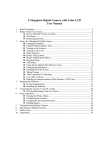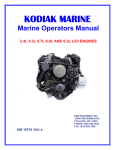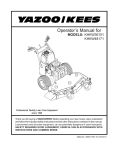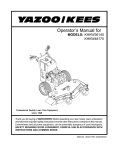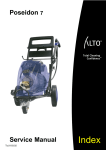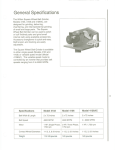Download Carburetion & Turbo Systems Vortec 8100 Operating instructions
Transcript
Industrial Alternate Fueled Engines 1.6L, 3.OL, 4.3L, 5.7L, 7.4L and 8.1L Engines Operation and Maintenance Manual .,=L =. Vortec 1600 Vortec 5700 ' Vortec 4300 Vortec 3000' Vortec 8100 Carburetion & Turbo Systems, Inc. 1897 Eagle CreekBlvd., Shakopee, MN 55379 A GM Powertrain Product Carburetion & Turbo Systems, Inc. 1897 Eagle Creek Blvd. Shakopee, MN 55379 Phone 952-445-3910 Fax 952-445-6070 Limited Warranty New GM Powertrain (GMPT) Engines in Original Equipment Manufacturers Industrial Power Applications Carburetion & Turbo Systems, Inc. (CTS) warrants each new engine supplied by CTS, for installation in its industrial applications that is found in normal use and service to be defective in factory material or workmanship, within a period of 12 months or 2000 hours, whichever comes first. It will reimburse or credit for necessary repairs or replacement of any defective or malfunctioning parts of such engine, with the exception of water pumps. Engine water pumps are not covered by any GMPT warranty, nor is it covered by any CTS warranty. Replacements must be made with genuine GMPT approved parts. The warranty period shall begin on the date the OEM industrial equipment is delivered to the first retail purchaser, or when the industrial equipment is first placed in service prior to sale at retail, however, the warranty period will commence no later than one year after the engine's model year production ends. THIS WARRANTY ONLY COVERS MALFUNCTIONS RESULTING FROM DEFECTS IN MATERIAL AND WORKMANSHIP. IT DOES NOT COVER LABOR REQUIRED TO REMOVE, REPLACE OR GAIN OR CLOSE ACCESS TO THE ENGINE OR POWER UNIT. This warranty does not cover malfunctions resulting from: Improper calibration of spark, fuel systems Water systems Misuse Negligence Accident Alterations not approved by GMPT or CTS Lack of performance of normal maintenance services Improper installation The replacement of maintenance items (i.e. spark plugs, ignition components, positive crankcase ventilator valve and filters) made in connection with normal maintenance service Loss of time, inconvenience, loss of use of equipment or other consequential damages In the event of a defect, the purchaser shall: Notify the dealer / distributor of any such defective part within 20 days Provide proof of purchase and in-service date to the dealer / distributor when requesting warranty Shall properly operate and maintain the engine in accordance with an authorized owner / operator manual LOSS OF TIME, INCONVENIENCE, LOSS OF USE OF THE EQUIPMENT, COMMERCIAL LOSS OR CONSEQUENTIAL DAMAGE ARE NOT COVERED TO THE EXTENT ALLOWED BY LAW. TABLE OF CONTENTS Warranty Information Introduction How to Use this Manual Engine Identification Parts and Service Operating Instructions Starting the Engine LPG or NG Fuel Systems, Velocity Governors Stopping the Engine Power Loss at Higher Elevations Maintenance Instructions Routine Maintenance Scheduled Preventive Maintenance Engine Oil Information Oil Filter Air Cleaner Safety Element Cooling System Belts Fuel Filter Ignition Systems Spark Plugs Storage (Preparing for and removing from) Appendix General Specifications Maintenance Schedule INTRODUCTION We are pleased that you have purchased a GM Powertrain engine from Carburetion & Turbo Systems, Inc. We take pride in providing quality products and support. Each engine is assembled with the alternative fuels carburetion to fit your specific requirements. However, certain checks should be made before placing the engine into service. Please read the Initial Start-Up Inspection Requirements in the Maintenance section of this manual. HOW TO USE THIS MANUAL This manual contains instructions on the safe operation and preventive maintenance of your engine. We urge you to read this manual prior to start-up or operation of this engine. Carburetion & Turbo Systems, Inc. engines are equipped with a variety of components to suit a broad range of customer requirements. This manual does not identify equipment as standard or optional, and not all the equipment described in this manual may be found on your engine. Please pay special attention to the NOTES, CAUTIONS, and WARNINGS. Warnings remind you to be careful in areas where carelessness can cause personal injury. Cautions are given to prevent you from error that could cause damage to the equipment. Notes give you added information designed to help you. ENGINE IDENTIFICATION An identification label is affixed to the right side of the engine on the rocker cover when looking at the engine from the flywheel end. (The engine serial number is also stamped into the left side of the cylinder block near the engine flywheel.) The label contains the engine model number and serial number. The engine model and serial number are required when seeking information concerning the engine and / or ordering replacement service parts. PARTS AND SERVICE Replacement parts, service and technical support can be obtained from Carburetion & Turbo Systems, Inc. by calling 952-445-3910. The engine model and serial number will be required when seeking information and 1 or ordering parts. STARTING THE ENGINE Warning: All internal combustion engine give off various fumes and gases while running. Do not start or run the engine in a closed or poorly ventilated building where exhaust gases can accumulate. Avoid breathing these fumes as they may contain poisonous carbon monoxide, which can endanger your health or life if inhaled even for a very short time. Caution: If the engine stalls or falters during starting, wait 3 to 4 seconds before reengaging the starter. This will prevent possible damage to the starter or the engine. DO NOT operate the starter for periods longer than 30 seconds at a time. An interval of at least 1 minute should be observed between cranking periods to protect the starter from overheating. LPG OR NG FUEL SYSTEMS, VELOCITY GOVERNORS Turn on the gas supply to the engine. Turn the ignition key to the START position. After the engine starts, release the key to the ON position. STOPPING THE ENGINE Following normal operating conditions, lower the engine speed to idle, pushing the throttle cable in on mechanical systems, or with electronic systems, placing the Hi 1 Lo switch in the Lo position. Run the engine for a few minutes at the idle to allow the coolant system to cool down before turning the ignition to the OFF position. Warning: Avoid injury when checking the Hot Engine. Allow the engine to cool down before removing the radiator cap. Caution: Before restarting the engine ensure that both the coolant system and the engine oil level have been checked and refilled if necessary. POWER LOSS AT HIGHER ELEVATIONS All engines will experience power loss when operated at elevations above sea level, unless they are turbocharged or supercharged. Turbochargers and superchargers are mechanical pumps that put extra air into the engine to make up for the lower air density at higher elevations. Carbureted Engines (Includes LPG and NG Systems): Carbureted engines will lose power for two reasons. First, power is reduced 3.5% for each 1000 feet the engine is operated above sea level, due to the decreased air density. With less dense air, the engine receives less oxygen to burn the fuel. The engine power is decreased in direct proportion to the reduction of available oxygen. Second, the reduced oxygen causes the fuel mixture to have too much fuel for the available oxygen. This is a rich mixture (rich with fuel) and not only causes the engine to produce sooty black exhaust, but also causes additional loss of power and premature spark plug fouling. Engines that are operated over 3000 feet of elevation that exhibit black smoke or produce less than optimum power should have the fuel system re-calibrated. Caution: Engines re-calibrated for high elevations will run lean at lower elevations. Lean running can burn valves, will reduce valve and valve seat life and can cause engine overheating. Failures caused by these problems are not covered under warranty. MAINTENANCE INSTRUCTIONS INITIAL START UP MAINTENANCE The initial start-up checks must be made before putting the engine into service. Please refer to the Maintenance Schedule on page I1 and perform the initial start-up operations in the sequence shown in column 1. ROUTINE MAINTENANCE Routine maintenance provides the best solution for making sure that the engine is ready when you are. The following are some routine service points: Make frequent checks of the engine oil and coolant levels Repair any oil or coolant leaks immediately Check battery condition and cables frequently Keep the engine air filter clean Monitor engine coolant temperature Monitor engine oil pressure Check voltmeter and charging system SCHEDULED PREVENTIVE MAINTENANCE Refer to the Maintenance Schedule on page I1 to ensure that all of the maintenance items listed are checked and replaced as recommended at the hours shown. ENGINE OIL LEVEL CHECK The engine oil level should be checked daily. It is recommended that the oil be checked just before the engine is started for the first time each day. The oil level should be between the Add and Full marks on the dipstick. Caution: Do not operate the engine with the oil level below the bottom or Add marks on the dipstick, or above the top or Full mark on the dipstick. ADDING ENGINE OIL It is normal to add some oil in the period of time between oil changes. The amount will vary with the severity of operation. When adding or replacing engine oil, be sure the oil meets or exceeds the recommended specifications. CHANGINE ENGINE OIL AND FILTER Under normal operating conditions, the engine oil and filter must be changed every 200 hours or every 3 months, whichever occurs first. (Changing Engine Oil and Filter continued) Under abnormal operating conditions, the oil and filter should be changed more often if the engine is operating in dusty or extremely dirty areas, or during cold weather. No oil additives or break-in oil change is required. ENGINE OIL QUALITY To achieve proper engine performance and durability, it is important that you use only engine lubricating oils of the correct quality in your engine. Proper quality oils also provide maximum efficiency for crankcase ventilation systems, which reduces pollution. Important: Use only engine oils displaying the American Petroleum Institute (API) "Starburst" certification marked "FOR GASOLINE ENGINES" on the container. Gasoline engines that are converted for LPG or NG fuels MUST use oils labeled "FOR GASOLINE ENGINES" also. Do not use oils that are specifically formulated for Diesel Engines only. CC or CD classification oils, even when labeled Heavy Duty or for Natural Gas Engines ARE NOT ACCEPTABLE. ENGINE OIL RECOMMENDATIONS Multi-viscosity oils are recommended. SAE 10W-30 is recommended for your engine from 0 degrees F (-1 8 degrees C) or above. If ambient temperatures are consistently below 0 degrees F, SAE 5W-30 oil can be used. Synthetic oils are not recommended for industrial or stationary engines. OIL FILTER The engines use an AC Delco oil filter as original equipment. An equivalent oil filter must be used when servicing the engine. Below is a chart showing the correct oil filter for your engine: Engine OilFilter 1.6L 94632619 3.0L PF-25 4.3L PF-47 or PF-52 5.7L PF- 1218 7.4L PF-1218 8.1L PF-454 The filter protects your engine from harmful, abrasive, or sludgy particles without blocking the flow of oil to vital engine parts. To replace the filter, use a proper oil filter wrench to remove the filter. Clean the filtermounting base and lightly coat the gasket surface of the new filter with engine oil. Hand tighten the filter until the gasket contacts the base, then tighten another '/2 turn. Fill the engine with the correct amount of oil, run the engine and check for oil leaks at the drain plug and oil filter gasket. Tighten as necessary to stop any oil leakage noted. ENGINE AIR CLEANER The engine air cleaner filters air entering the engine intake system and acts as a silencer and flame arrester when assembled to the intake system. A dirty air cleaner produces an abrasive fuel mixture and can cause severe damage to the cylinder walls and piston rings. Damage to the cylinder walls and piston rings will cause high oil consumption and shorten the life of the engine. Caution: Under severe dusty or dirty conditions, replace the air cleaner more frequently. Remove the primary air cleaner element from the air cleaner assembly and inspect the element for foreign material restrictions or signs of excessive wear or damage. Replace the element if necessary. Remove all dust and foreign matter from the air cleaner housing. Reinstall the air cleaner element, the air cleaner cup and securely fasten the retaining clips. SAFETY ELEMENT If your engine is equipped with an air cleaner, which utilizes a safety element, ensure the element is properly in place before installing the primary element. Change the safety element annually. COOLING SYSTEM Coolant Level: Check the coolant level of the radiator daily and only when the engine is cool. Generally, a good time to do this is just prior to starting the engine for the first time each day. Maintain the coolant level at 34 to 1-112 inches below the filler neck seat of the radiator when the coolant is cold. In addition, when checking the coolant level, also inspect the condition of the radiator cap rubber seal. Make sure it is clean and free of any debris that would keep it from seating on the filler neck seat. Rinse off with clean water if necessary. Make sure that the filler neck seat is free of any dirt particles also. Warning: Never remove the radiator cap while the engine is running under any circumstances! Failure to follow these instructions could result in damage to the cooling system or engine, or could cause personal injury. Removing the radiator cap from a hot radiator may cause scalding hot coolant to stream or blow out of the radiator. Wait until the engine has cooled, then wrap a thick cloth around the radiator cap and turn slowly to the first stop. Step back while the pressure is released from the cooling system. When all the pressure has been released, press down on the cap and remove it slowly. DO .NOT add coolant to any engine that has become overheated until the engine cools. Adding coolant to an extremely hot engine can result in a cracked block or cylinder head. Use only a permanent type coolant when refilling or flushing the coolant system. Recommended ethylene glycol mix 52/48 is normal up to a maximum of 60% glycol, 40% water. Refer to the mixture chart on the container for additional antifreeze protection information. DO NOT use alcohol or methanol antifreeze, or mix them with the specified coolant. Plain water may be used in an emergency (except in fieezing temperatures), but replace it with the specified coolant as quickly as possible to avoid damage to the system. Radiator: Inspect the exterior of the radiator for obstructions. Remove all foreign material with a soft brush or cloth. Use care to avoid damaging the core fins. If available, use low-pressure compressed air or a stream of water in the opposite direction of the normal airflow. Check all hoses and connections for leaks and replace if cracked, frayed or spongy. Fan Belts: The water pump is usually belt driven. The same belt may also drive the fan and (or) the alternator. Belts should be properly adjusted at all times. A loose belt can cause improper alternator fan and water pump operation, and can also cause overheating. Serpentine Belt: Some engines utilize serpentine belts on the front of the engine. This type of belt system incorporates a belt-tensioning device, which keeps the belt at the proper tension. This belt should be checked regularly for cracks or "checking" on the groove side of the belt. If a problem is apparent, the belt must be replaced. V-Type Belt: V-Type belts are generally tensioned by adjusting the alternator, or through a mechanical belt tensioner. The belt is generally correctly tensioned when there is % inch of depression on the belt between the water pump and the crankshaft pulley. FUEL FILTER Carbureted Engines: On carbureted engines, an in-line filter is incorporated into the fuel supply line. It is recommended that this filter be changed every 250 hours or every 6 months whichever occurs first. IGNITIONS SYSTEMS There are three types of ignition systems used on the GM Powertrain engines. Solid State Electronic Distributor Solid State Electronic Distributor with Electronic Control Unit (ECU) Distributor-less Electronic Ignition with ECU Please refer to the General Specific chart to determine the ignition system used on your particular engine. Ignition Timing: Proper adjustment of the ignition timing must be obtained to provide the optimum engine power output and economy. Spark Plugs: Spark plugs should be replaced at the recommended intervals described in the Maintenance Schedule. Use only the recommended spark plug or an equivalent as described in the General Specifications, where you will also find the gap specifications. When removing spark plugs, always note which cylinder each spark plug came out of. Inspection of the spark plug can detect engine problems. Look at the porcelain around the center electrode of each plug. If there are glossy brown deposits, that cylinder is burning excess oil. (Spark Plugs continued) If there are dark gray or sooty black deposits, your engine is running rich and you are burning excess fuel. The optimum color of the deposits on the porcelain is light tan or light brown. This shows optimum fuel mixture and proper engine running conditions. If the deposits are almost white, the engine may be running excessively lean. Lean running is very detrimental to your engine life and should be corrected immediately. If one or more cylinders are burning oil, the smoke from the engine will be a blue-gray color. Most common causes are worn out piston rings or rings that are not broken in, or cut, nicked or worn out valve stem seals. If the engine is running rich, the exhaust smoke will be a sooty black color. STORAGE One to Six Months:, If the engine or machine is to be placed in storage for a period of one to six months, it is recommended that the following steps be followed: Add a fuel conditioner such as "Stabil" or equivalent to the fuel tank as recommended on the bottle. Run the engine for approximately 10 to 15 minutes to insure that the treated fuel is completely through the fuel system Fill the tank with fuel Protect the air cleaner inlet from water entry Check the coolant protection and top off radiator Store indoors if possible For Extended Periods: Follow the above recommended procedures, plus do the following: Drain the engine crankcase and refill with recommended oil Change the oil filter Disconnect and remove the battery Clean exterior surface of the engine Removing the Engine from Extended Storage: Install a fully charged battery Remove all protective coverings from the air inlet, air cleaner, exhaust and muffler openings Check the coolant level in the radiator and verify the protection level of the coolant Start the engine and allow it to run at slow idle, verify engine oil pressure Run the engine at idle until the coolant temperature approaches 120 degrees F (49 degrees C) Shut the engine down, drain the oil, change the oil filter and refill with the recommended grade of oil GENERAL SPECIFICATIONS Maintenance Schedule GM Powertrain - 1.6L, 3.OL, 4.3L, 5.7L, 7.4L, and 8.1L Engines I I I I I I I (I) More frequent intervals may be required in dusty or d i m operating conditions. (2) Mechanical governor (belt driven). (3) To be performed at specified interval or ennoally, whichever occurs tlnt (4) More frequent intervals may be required with dirt In the fuel system. (5) DM not apply to engines with DIS ignition. I 31 qt (Turbo) I IT I I I -MPcam WiringDiagrams ALTERNATOR-DELCOREMY i ir T H I S T E R M I N A L 7 0 BE C O N N E C T E D THRU A INDICATOR L I G H T . OR 1 0 - 5 0 OHM R E S I S T O R , OR OlOOE TO A IGF!ITION SWITCH T E R M I N A L VOLTAGE S E N S I N G T E R M I N A L Not USW Indiea:or Camp = white w black w h lgnllkn (crenk & run) = red w Wue w ~ r e Exte3al Sense (banery voltage) + red wire






















